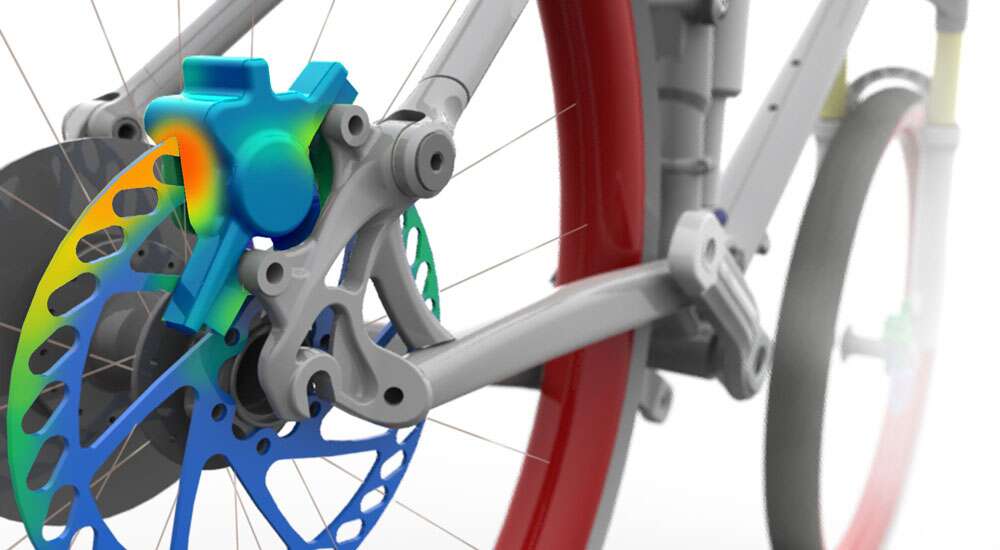- Fully embedded in SOLIDWORKS for ease of use and data integrity.
- Same user interface as SOLIDWORKS (toolbars, menus and context-sensitive right-click menus). SOLIDWORKS users can get up to speed rapidly with SOLIDWORKS Simulation.
- Associativity with SOLIDWORKS design changes.
- Support for SOLIDWORKS materials and configurations for easy analysis setup.
- Overlay of simulation results onto SOLIDWORKS CAD graphics.
SOLIDWORKS Simulation
Subject your designs to real world conditions to raise product quality while reducing prototyping and physical testing costs.
Why Choose SOLIDWORKS Simulation?
SOLIDWORKS® Simulation is an easy-to-use portfolio of structural analysis tools that use Finite Element Analysis (FEA) to predict a product’s real-world physical behavior by virtually testing CAD models. The portfolio provides linear, non-linear static and dynamic analysis capabilities.

Which SOLIDWORKS Simulation package is right for you?
SOLIDWORKS Simulation Standard
SOLIDWORKS Simulation Standard is an intuitive virtual testing environment for static linear, time-based motion, and high-cycle fatigue simulation. It delivers a concurrent engineering approach, helping you know if your product will perform properly and how long it will last—during the design phase.
SOLIDWORKS Simulation Professional
SOLIDWORKS Simulation Professional enables you to optimize your design, determine product mechanical resistance, product durability, topology, natural frequencies, and test heat transfer and buckling instabilities. It can also perform sequential multi-physics simulations.
SOLIDWORKS Simulation Premium
SOLIDWORKS Simulation Premium lets you efficiently evaluate your designs for nonlinear and dynamic response, dynamic loading, and composite materials. SOLIDWORKS Simulation Premium includes three advanced studies: Non-Linear Static, Non-Linear Dynamic, and Linear Dynamics.
Need a detailed comparison between these offers?
| SOLIDWORKS Simulation Standard | SOLIDWORKS Simulation Professional | SOLIDWORKS Simulation Premium | ||
|---|---|---|---|---|
| Fully integrated in SOLIDWORKS® 3D CAD | ||||
|
|
||||
| FEA Modeling | ||||
|
||||
| Interactions and Connectors | ||||
|
||||
| Loads and Constraints | ||||
|
||||
| Stress Hot Spot Diagnostics | ||||
|
||||
| Communication with Reports and eDrawings® | ||||
|
||||
| Linear Static Simulation for Assemblies | ||||
|
||||
| Time-Based Motion | ||||
|
||||
| Design Comparison Studies | ||||
|
||||
| Fatigue Simulation | ||||
|
||||
| Trend Tracker | ||||
|
||||
| Automatic Conversion of Toolbox Fasteners to Bolts | ||||
|
||||
| Design Optimization | ||||
|
||||
| Load Case Manager | ||||
|
||||
| Advanced Interactions and Connectors | ||||
|
||||
| Topology Optimization Studies | ||||
|
||||
| Event-Based Motion Simulation | ||||
|
||||
| Frequency Simulation | ||||
|
||||
| Buckling or Collapse Simulation | ||||
|
||||
| Thermal Simulation | ||||
|
||||
| Drop Test Simulation | ||||
|
||||
| Pressure Vessel Design | ||||
|
||||
| Submodeling Simulation | ||||
|
||||
| 2D Simplification | ||||
|
||||
| Linear Dynamic Simulation | ||||
|
||||
| Nonlinear Simulation | ||||
|
||||
| Composites Simulation | ||||
|
Analysis of structural response of composite, which is mixture of two or more materials. |
||||
Have questions about SOLIDWORKS Simulation?
GDS Middle East is a leading Authorized Reseller for SOLIDWORKS Simulation in UAE and Saudi Arabia. We have sales & technical support offices in UAE and Saudi Arabia. We can help you invest in your future by learning the SOLIDWORKS Simulation.
